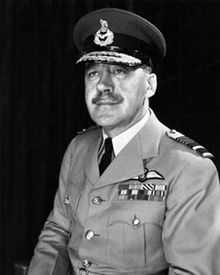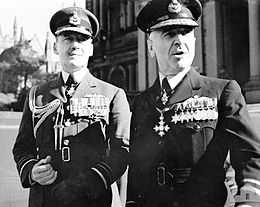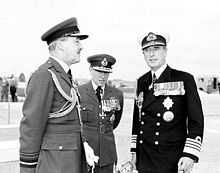Donald Hardman
| James Donald Innes Hardman | |
|---|---|
 Air Marshal Donald Hardman as RAAF Chief of the Air Staff | |
| Born |
21 December 1899 Oldham, Lancashire, England |
| Died |
2 March 1982 (aged 82) Portugal |
| Allegiance |
|
| Service/branch |
|
| Years of service | 1916–1958 |
| Rank | Air Chief Marshal |
| Unit |
No. 19 Squadron (1918) No. 31 Squadron (1922–1926) No. 216 Squadron (1931–1935) |
| Commands held |
No. 232 Group (1945–1946) Staff College, Bracknell (1949–1951) Home Command (1951–1952) RAAF (1952–1954) |
| Battles/wars |
|
| Awards |
Knight Grand Cross of the Order of the British Empire Knight Commander of the Order of the Bath Distinguished Flying Cross Mentioned in Despatches |
Air Chief Marshal Sir James Donald Innes Hardman GBE, KCB, DFC (21 December 1899 – 2 March 1982) was a senior Royal Air Force commander. He began his flying career as a fighter pilot in World War I, achieving nine victories to become an ace. During World War II, Hardman held staff and operational posts. He was Chief of the Air Staff of the Royal Australian Air Force from 1952 to 1954, after which he served as a member of the British Air Council until his retirement in 1958.
World War I
Born in Oldham, Lancashire,[1] Hardman was educated at Malvern College and Hertford College, Oxford. He began his military career in the Artists' Rifles in 1916, and joined the Royal Flying Corps early in 1917. Hardman gained his commission in May but was prevented from seeing combat immediately because of his age. He was eventually posted to No. 19 Squadron in February 1918, flying Sopwith Dolphins on the Western Front. Hardman scored two kills in one sortie on 30 October 1918, an action that earned him the Distinguished Flying Cross. He finished the war a flight commander and temporary Captain in the recently formed Royal Air Force (RAF), with a total of nine victories.[2]
Inter-war years
When the war ended, Hardman left the military for further study at Oxford, but rejoined the RAF in 1921. He was granted a short service commission as a Flying Officer and posted to No. 31 Squadron in India.[2] Gaining his permanent commission in 1925,[3] he was promoted to Flight Lieutenant in 1927.[4] Hardman served as both pilot and armament officer with various units in the late 1920s and early 1930s, and completed courses at both Army and Air Force staff colleges.[2] He married Dorothy Thompson in 1930; the couple had two sons and a daughter.[5] A member of No. 216 Squadron from 1931 to 1935,[2] Hardman was promoted Squadron Leader in February 1936,[6] and Wing Commander in January 1939.[2]
World War II
On the outbreak of World War II Hardman was sent to France with the Air Component of the British Expeditionary Force, preparing airfields on the Western Front for the arrival of RAF units. He was appointed an Officer of the Order of the British Empire in July 1940,[2][7] and Mentioned in Despatches in January 1941.[8] In March, he was promoted temporary Group Captain.[9] Hardman served as Director of Military Cooperation at the Air Ministry in 1944, before being posted to Air Command South East Asia (ACSEA) as Commander, Combat Cargo Task Force, at the end of the year.[10] In mid-1945 he became Air Officer Commanding No. 232 (Transport) Group, and was made a Companion of the Order of the Bath (CB).[11] He finished the war with the temporary rank of Air Commodore,[2][12] and a substantive Group Captain.[13]
Post-war career

Hardman was promoted to acting Air Vice Marshal on 1 October 1945.[14] He remained in South-East Asia following the end of World War II, taking over as Air Officer in Charge of Administration for ACSEA in January 1946. He served in a number of senior posts in the RAF after his return to Britain including Assistant Chief of Air Staff (Operations) in 1947–1949, Commandant of RAF Staff College, Bracknell, in 1949–1951 and Air Officer Commanding-in-Chief of Home Command in 1951–1952.[10] Hardman's wartime rank of Air Commodore became substantive in October 1946,[15] followed by substantive promotion to Air Vice Marshal in July 1948,[16] and acting Air Marshal in October 1951.[17]
In January 1952, Hardman was appointed Chief of the Air Staff (CAS) of the Royal Australian Air Force, succeeding Air Marshal George Jones, whose ten years in the position was the longest continuous term of any RAAF chief. The decision by Australian Prime Minister Robert Menzies to appoint an RAF officer caused resentment in the Air Force, compounded when he stated his reason as being that there was "no RAAF officer of sufficient age, or operation experience, to take the post of Chief of the Air Staff", ignoring the wartime records of such figures as John McCauley and Frederick Scherger. The Daily Mirror in Sydney was one of a number of media outlets to voice a "stern protest" over the matter. RAF CAS Sir John Slessor, responsible for fulfilling the Australian Government's request for a suitable officer, considered Hardman the "outstanding candidate" for the Australian post, trying to avoid what he called "the follies of some years ago", referring to Air Chief Marshal Sir Charles Burnett's controversial tenure as CAS on secondment from Britain in the early years of World War II.[18]

Hardman changed the structure of the Air Force from one based on geographical area to one based on function, creating Home (operational), Maintenance (support), and Training Commands.[19] The functional system of command has been described by historian Alan Stephens as Hardman's "major legacy to the RAAF".[20] While doing away with Jones' area command system, Hardman carried on his predecessor's support for the local aircraft industry.[21] He also formed a policy agreement with Navy Chief of Staff Vice Admiral Sir John Collins, covering joint responsibility and cooperation for maritime warfare.[22] Under Hardman's tenure, No. 78 Fighter Wing was reformed and deployed to Malta on garrison duty.[23] He was appointed a Knight Commander of the Order of the Bath in the Queen's Birthday Honours of June 1952,[24] and raised to substantive Air Marshal the following month.[25] Towards the end of his term, he gave an interview in which he criticised Army and Navy operations against a background of continuing interservice rivalry for the defence budget.[26] In contrast to the initial disquiet at his appointment, however, upon his departure from Australia Hardman was described by The Age as "the outstanding CAS in the RAAF's history" and a "brilliant organiser".[27]
Hardman served on the British Air Council as Air Member for Supply and Organisation from 1954 to 1958, gaining promotion to Air Chief Marshal on 1 April 1955.[2] On 11 July 1956, he presented a Squadron Standard to his old unit, No. 19 Squadron.[28] That October, he presided over the inquiry into the fatal crash of Avro Vulcan XA897 at Heathrow Airport after its maiden round-the-world flight, the only survivors being the pilot and Air Marshal Sir Harry Broadhurst. Hardman was made a Knight Grand Cross of the Order of the British Empire on 1 January 1958, and retired from the RAF later that month.[2] He died in 1982 while taking an overseas holiday.[5]
Honours and awards
- Knight Grand Cross of the Order of the British Empire - 1 Jan 1958 (OBE - 11 Jul 1940)
- Knight Commander of the Order of the Bath - 5 Jun 1952 (CB - 5 Jul 1945)
- Distinguished Flying Cross - 8 Feb 1919
- Mentioned in Despatches - 1 Jan 1941
- Distinguished Service Medal (United States) - 15 Mar 1946
Notes
- ↑ James Hardman at The Aerodrome. Retrieved on 30 January 2008.
- ↑ 2.0 2.1 2.2 2.3 2.4 2.5 2.6 2.7 2.8 Air Chief Marshal Sir Donald Hardman at Air of Authority. Retrieved on 21 January 2008.
- ↑ The London Gazette: no. 33094. p. 6776. 20 October 1925. Retrieved 2008-01-31.
- ↑ The London Gazette: no. 33290. p. 4239. 1 July 1927. Retrieved 2008-01-31.
- ↑ 5.0 5.1 "A C/M Sir D. Hardman". The Times: p.14. 9 March 1982.
- ↑ The London Gazette: no. 34252. p. 737. 4 February 1936. Retrieved 2008-01-31.
- ↑ The London Gazette: no. 34893. p. 4253. 9 July 1940. Retrieved 2008-01-31.
- ↑ The London Gazette: no. 35029. p. 33. 31 December 1940. Retrieved 2008-01-31.
- ↑ The London Gazette: no. 35102. p. 1448. 11 March 1941. Retrieved 2008-01-31.
- ↑ 10.0 10.1 Liddell Hart Centre for Military Archives at King's College London. Retrieved on 29 January 2008.
- ↑ The London Gazette: (Supplement) no. 37161. p. 3491. 3 July 1945. Retrieved 2008-01-31.
- ↑ The London Gazette: (Supplement) no. 36780. p. 5073. 3 November 1944. Retrieved 2008-01-31.
- ↑ The London Gazette: (Supplement) no. 36902. p. 507. 19 January 1945. Retrieved 2008-01-31.
- ↑ The London Gazette: (Supplement) no. 37336. p. 5385. 2 November 1945. Retrieved 2008-01-31.
- ↑ The London Gazette: (Supplement) no. 37758. p. 5080. 11 October 1946. Retrieved 2008-01-31.
- ↑ The London Gazette: (Supplement) no. 38344. p. 3895. 2 July 1948. Retrieved 2008-01-31.
- ↑ The London Gazette: (Supplement) no. 39520. p. 2169. 18 April 1952. Retrieved 2008-01-31.
- ↑ Stephens, Going Solo, pp. 73–74
- ↑ Helson, 10 Years at the Top, pp.293–294
- ↑
- ↑ Stephens, Going Solo, pp. 188–190
- ↑ Stephens, Going Solo, p.397
- ↑ Stephens, The Royal Australian Air Force, pp. 221–222
- ↑ The London Gazette: (Supplement) no. 39555. p. 3009. 30 May 1952. Retrieved 2008-01-31.
- ↑ The London Gazette: (Supplement) no. 39586. p. 3581. 27 June 1952. Retrieved 2008-01-31.
- ↑ Dennis et al., The Oxford Companion to Australian Military History, p.287
- ↑
- ↑ No 16 - 20 Squadron Histories at Air of Authority. Retrieved on 21 January 2008.
References
- Dennis, Peter; Grey, Jeffrey; Morris, Ewan; Prior, Robin (1995). The Oxford Companion to Australian Military History. South Melbourne: Oxford University Press. ISBN 0-19-553227-9.
- Helson, Peter (2006). Ten Years at the Top. University of New South Wales.
- Stephens, Alan (1995). Going Solo: The Royal Australian Air Force 1946–1971. Canberra: Aust. Govt. Pub. Service. ISBN 0-644-42803-1.
- Stephens, Alan (2006) [2001]. The Royal Australian Air Force: A History. London: Oxford University Press. ISBN 0-19-555541-4.
External links
| Wikimedia Commons has media related to Donald Hardman (RAF officer). |
| Military offices | ||
|---|---|---|
| Preceded by Air Marshal Sir George Jones |
Chief of the Air Staff (RAAF) 1952–1954 |
Succeeded by Air Marshal Sir John McCauley |
| Preceded by Sir John Whitworth-Jones |
Air Member for Supply and Organisation 1954–1957 |
Succeeded by Sir Walter Dawson |
| ||||||||||||||